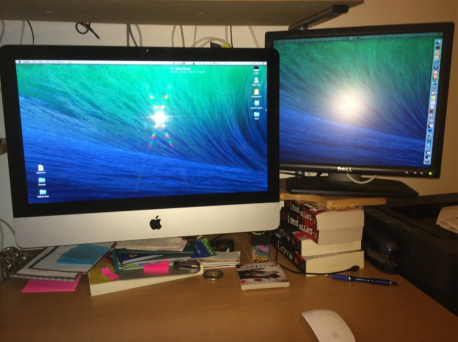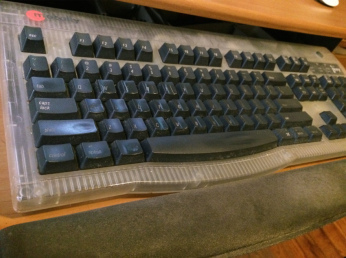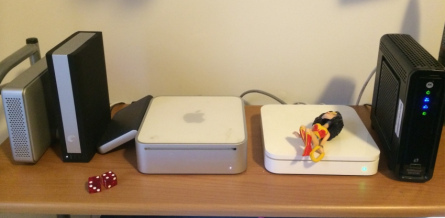Barry Lyga's Blog: The BLog, page 43
July 24, 2014
For the Tech of It Addendum: Backup
In the post on backing up, I forgot to mention one crucial factor:
You must occasionally test your backups!
Every now and then, try to pull a file from your backups. Restore a couple of things you deleted a while back. Just to make sure everything is working. Computers are machines and machines fail — there is a chance your backup will become corrupt or otherwise borked. (One more reason to have multiple systems in place!) So, take a minute once a month or so and make sure everything is working. Odds are it is, but if not, better to catch it (and fix it) sooner rather than later.
July 23, 2014
For the Tech of It: Backup
When I was a kid, I sat dutifully at my desk every day, pounding away at my Atari 800XL computer to craft short stories, comic book scripts, and even a novel.
For reasons I don’t recall, all of my computer equipment was plugged into an outlet controlled by my bedroom light switch. Most likely, that was the nearest and most readily available outlet, usable without resorting to a web of extension cords.
You see where this is going, I’m sure.
One evening, I headed to the kitchen for a snack while in the middle of working on what I thought would surely be my masterpiece. (I remember that story very well, in fact. It wasn’t my masterpiece.) My mother, walking past my room, was annoyed that my light was on…and reached in to flip the switch.
Boom. In an instant, my computer shut down and I lost everything.
Man oh man, do I wish I’d had a backup.
Of course, in those bad old days, backups were arduous. You had to pop out one disc, insert another, and wait forever for the file to copy over. And sometimes the process of copying the file would cause some sort of corruption and you would lose the file anyway…in the process of trying to preserve it!
So it’s no mystery that back then, very few people backed up, leaving their work to the tender mercies of power outages, disc corruption, human error, and mercurial moms looking to shave some bucks off the power bill.
These days, you have no excuse not to backup your work. And by backing up, I don’t mean occasionally remembering to plug in a USB key and copy over whatever you just worked on that day, or dragging some files into your Dropbox. I mean a constant, always-on backup that preserves everything.
Here’s how I do it.
Remember this shot from last time?
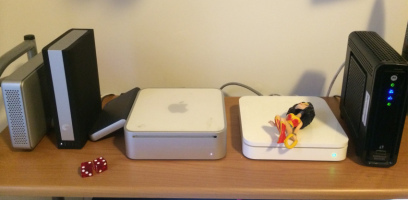 That’s the shelf above my computer. The second item from the left is a Seagate 2TB hard drive, connected directly to my iMac via a FireWire cable. Its name is Rond Vidar and it’s my Time Machine backup drive.
That’s the shelf above my computer. The second item from the left is a Seagate 2TB hard drive, connected directly to my iMac via a FireWire cable. Its name is Rond Vidar and it’s my Time Machine backup drive.
Time Machine, for those of you who don’t know, is Apple’s automatic backup system. It’s so simple I feel brain-dead even talking about it: You plug in a drive (via FireWire, Thunderbolt, or USB) and the system automatically says, “Hey, would you like to use this as a Time Machine volume?” You click “You betcha!”1 and henceforth the OS automatically backs up your drive’s contents every hour. Every hour. Of every day. Forever. Keeping each hour segregated so that you can step back through time (get it?) and recover documents from August 4, 2013 at 2pm, for example. (As the drives fills up, Time Machine intelligently and automatically deletes the oldest backups if it needs the space. I have a 2TB drive that I’ve used for over a year now and it hasn’t needed to delete anything at all.)
When backing up is this simple, you’d be an idiot not to use it. (That’s right: If you’re not using it, I just called you an idiot. Prove me wrong.) I’m reasonably certain that Windows has a similar function, so there’s no excuse on that end.
Problem solved, right? Nope — there are two issues with what I’ve just described.
The first is this: In order for Time Machine to work, you need to be connected to the backup drive. For me, that’s no problem: My iMac is damn near bolted to my desk 24/7, so a FireWire cable suffices. But if you’re using a laptop, you’ll be all over the place, and you’re not going to want to fuss with a cable and an external hard drive. As a result, you’ll only back up when you happen to remember to connect to that drive…which is about as useful as not backing up at all.
The solution? A wireless backup. You can buy, for example, Apple’s Time Capsule, which is a wireless router with a hard drive inside. As long as you’re connected to your home wifi network, your machine will automatically perform hourly Time Machine backups, whether you’re tethered or not. Yes, your laptop will back itself up while you surf the web on the toilet. Score!
In my house, I needed a wireless solution because my wife uses a laptop, and when I asked what she did for backup, she gestured vaguely to a hard drive and said, “Sometimes I plug that in.” No way. Not in my house.
So in that picture above, take a look at the Mac mini with a hard drive dangling from it. I set that up as a backup server for her. The hard drive in the mini was too tiny to hold her backups, so I added that external one. Then I added the mini to the network and pointed her Time Machine to the volume on the mini. It work beautifully, and I was able to cobble it together with stuff I already owned.
I said before that there were two problems with the Time Machine backup. We’ve solved the first one — wireless backup — but here’s the second one:
The Time Machine is on-site.
Off-site backup (i.e., a backup located geographically distant from your location) is extremely important. If your computer crashes and you lose some data, yes, you can restore it from your on-site backup.
But what if your house is flooded? Or burned to the ground? Or a lightning strike fries your electronics? Or someone steals your computer…and grabs the hard drive sitting next to it? Or heck — what if you get really unlucky and your computer and your backup drive both just up and die?
In those instances (and many others), you’re screwed.
So, you need an off-site backup. You could regularly take a second hard drive with a backup and stash it at work or your parents’ house or the gym or whatever, but that’s a lot of work. And inevitably, you’ll screw up and forget to do it and then you’re back at square one.
Fortunately, there’s this handy thing called the Internet, and it will let you back up your system to a remote location. You’ll need to install some software and that first backup will take forever as your system uploads everything on your hard drive to a safe, encrypted server elsewhere. When I say forever, I mean anywhere from a week to a month, depending on how much stuff you’ve got on your hard drive. (Don’t worry — you can still use your computer while it’s uploading!) But it’s worth it. For the peace of mind.
Here are some great, reputable online, off-site backup services. They are reasonably priced and well-regarded:
Backblaze
Carbonite
Crashplan
For the record, I use Crashplan, but I don’t back up to their servers. They offer a plan whereby you can back up your system to another computer, anywhere on the Internet. So I have a hard drive hooked up to a friend’s computer in another part of the country and I back up to that. If disaster strikes, he can mail the drive to me.
With all of this work done, you’d think I would feel pretty secure. Actually, I don’t. I should take one more step and use something like SuperDuper to make a clone of my system. A clone isn’t just a backup of important documents and what-have-you. It’s an exact duplicate of your system that you can boot off of, just like the original. So if your main hard drive grinds to a halt, you can plug in the clone, reboot, and be back at work in seconds. I haven’t set this up yet, and I should.
You may be thinking this is an awful lot of work. You may be thinking “I’ve never had a hard drive die on me. And the odds of it happening are slim.”
Maybe so. But computers are machines. And machines fail. Eventually.
It doesn’t really say “You betcha!”
July 22, 2014
A Cool Apple Ad
A very unusual — for Apple — ad, but very cool nonetheless.
I think that more shocking than Apple celebrating people mucking up Sir Jony’s gorgeous aluminum laptop with their stickers is the blink-and-you’ll-miss-it return of the original, beloved rainbow Apple logo.
(hat tip to The Loop)
July 21, 2014
For the Tech of It: Hardware (Desktop)
I am frequently asked about the tools of the trade. Since writing doesn’t usually involve sawdust or any sort of protective goggles, those tools are pretty much digital.1 So, I’m going to do some BLogs wherein I go through my digital toolbox, starting today with where most of my work gets done: On my desktop.
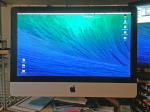 Up above, you can see a shot of my current set-up. Yes, my desk is always this neat and organized.2 Unlike pretty much every other author in the known universe, I don’t use — or even own — a laptop. I love the nice big 21″ screen on my 2011 iMac.3 I can crank up the font size as big as I want, kick back in my chair, and write.
Up above, you can see a shot of my current set-up. Yes, my desk is always this neat and organized.2 Unlike pretty much every other author in the known universe, I don’t use — or even own — a laptop. I love the nice big 21″ screen on my 2011 iMac.3 I can crank up the font size as big as I want, kick back in my chair, and write.
 To the right of the iMac, you’ll notice a second screen. That’s a Dell 1704FPT. It’s a relatively ancient monitor, but a recent addition to my set-up. For years, I’ve read about how a second screen can increase productivity and I’ve always wanted to dabble in it. But monitors can be sort of expensive, and my desk’s configuration isn’t really designed for a second monitor. However, I reasoned that a smallish monitor (the Dell is only 17 inches) might fit…and that if I went for an older monitor, the cost wouldn’t be too high. That way, if I ended up not liking the two-screen solution, I wouldn’t have wasted big bucks on a nice, high-end monitor.
To the right of the iMac, you’ll notice a second screen. That’s a Dell 1704FPT. It’s a relatively ancient monitor, but a recent addition to my set-up. For years, I’ve read about how a second screen can increase productivity and I’ve always wanted to dabble in it. But monitors can be sort of expensive, and my desk’s configuration isn’t really designed for a second monitor. However, I reasoned that a smallish monitor (the Dell is only 17 inches) might fit…and that if I went for an older monitor, the cost wouldn’t be too high. That way, if I ended up not liking the two-screen solution, I wouldn’t have wasted big bucks on a nice, high-end monitor.
Well, let me tell you: That monitor is the best 35 bucks I’ve ever spent on eBay.4 I love it. It’s just right size for the space on my desk and it allows me to keep certain apps and windows segregated from the main display. The other day, I was trying to figure something out in Photoshop, so I ran the tutorial video on the Dell and had Photoshop open on the iMac. It was perfect. Plus, the monitor acts as a USB hub, so it’s expanded my available USB ports without requiring a separate hub cluttering up my desk. You can never have too many USB ports.
For input, I rock the Apple Magic Mouse that came with the iMac. I’ve seen a lot of places online where 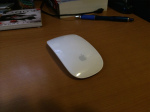 people rag on the Magic Mouse for being unergonomic, but I have to say that it fits my hand perfectly. I love the buttonless design. I tweak the Magic Mouse with a way-cool piece of software called BetterTouchTool. It adds all kinds of functionality to the Magic Mouse, so that I can sweep through Spaces with just a swipe, start and stop iTunes playback with a tap, and stuff like that. Very customizable and it really beefs up the Magic Mouse.
people rag on the Magic Mouse for being unergonomic, but I have to say that it fits my hand perfectly. I love the buttonless design. I tweak the Magic Mouse with a way-cool piece of software called BetterTouchTool. It adds all kinds of functionality to the Magic Mouse, so that I can sweep through Spaces with just a swipe, start and stop iTunes playback with a tap, and stuff like that. Very customizable and it really beefs up the Magic Mouse.
And here’s where most of the work really happens:
That, friends, is the MacAlly iKey keyboard, a relic of the late nineties, back when I bought a PowerMac G4 tower. I hated the keyboard that came with the G4, so I bought this little baby, and I’ve used it ever since. With the exception of a couple of chapters of Boy Toy (written on an old laptop) and the times when I decamp for a coffeeshop to write with my iPad, every word I’ve ever published has been typed on this keyboard. Yes, it is magical and when it finally dies, I figure my writing career will be over; they don’t make ‘em any more.
I use a wrist-rest because RSIs like CTS are no fun.
So, that’s the main set-up. Let’s take a quick look at the peripherals:
My printer is a Brother HL-2270DW. I don’t know why printer companies insist on using such  ridiculous naming schemes, but there you have it. There’s nothing exceptional about this printer; it’s your basic laser printer and it fits in the small space available to it in my cramped little office. I bought this particular flavor because I’ve had good luck with Brother printers in the past, it was pretty cheap, and it’s wireless (so I can share it with my wife without cables). Oh, and it also prints on both sides of the paper. That wasn’t a requirement, but it’s nice to have. The ink isn’t terribly expensive, either. It holds about 250 sheets of paper (or half a Lyga novel, heh) and also does envelopes, etc. The usual. It has survived multiple printings of The Book That Will Kill Me, so you know it’s gotta be sturdy!
ridiculous naming schemes, but there you have it. There’s nothing exceptional about this printer; it’s your basic laser printer and it fits in the small space available to it in my cramped little office. I bought this particular flavor because I’ve had good luck with Brother printers in the past, it was pretty cheap, and it’s wireless (so I can share it with my wife without cables). Oh, and it also prints on both sides of the paper. That wasn’t a requirement, but it’s nice to have. The ink isn’t terribly expensive, either. It holds about 250 sheets of paper (or half a Lyga novel, heh) and also does envelopes, etc. The usual. It has survived multiple printings of The Book That Will Kill Me, so you know it’s gotta be sturdy!
And rounding out the peripherals, we look above the iMac, to a shelf unit built into the desk:
So, from left to right:
An iomega eGo Desktop 2TB hard drive. I bought this as a Time Machine backup drive for my iMac several years ago. I believe they are now discontinued, so no link. It was a fine backup drive for a while, but it started getting flaky and slow, so I decommissioned it from service. Now it serves as a holding place for big files that I don’t want to keep on my main drive.
Seagate Backup Plus. Another 2TB drive. This is my current Time Machine volume, named Rond Vidar. (The comic book geeks get it.) and it works beautifully. Nice and quiet, too, which is important to me. When I’m in the writing zone, I hate being yanked out by random clicks, whirrs, and fan-spins of a backup drive. (Seagate has remodeled the Backup Plus, so the one at that link doesn’t look like mine shown above.)
Next up is an ancient 2006 Mac mini with a Western Digital drive hanging off of it. Nothing to say here — these aren’t part of my writing setup at all. They form a makeshift house-wide media server.
Wonder Woman is perched atop my Airport Extreme, which serves up wireless to everyone throughout the house. (Except for the iMac — I have the iMac hardwired directly into the Airport since they’re right next to each other. Also, this way if something goes pear-shaped with wireless, I have a system jacked right in for troubleshooting.) This is the original model of the Airport Extreme, from way back in 2007. I should probably upgrade, but it’s been working fine, so why bother?
And finally, my cable modem. Which I had no say in. It came from Time-Warner Cable. Whatevs.
At one point, I had a scanner, but ran out of room for it, so I ditched it. I kinda wish I hadn’t because while there are apps that will turn your iPad into a scanner, they’re not as dead-simple as a dedicated scanner. Ah, well.
Whew! So, that’s a walk through my desktop hardware. This is the stuff that gets me through every single writing day, pretty much. Next time, I’m going to talk about backup strategies, which sounds like boring, eat-your-vegetables stuff, but seriously — it’s really important and most people I know don’t really think about it. I’ll show you how to set it and forget it so that you never have to worry about losing something again.
I almost never use anything but a computer, from note-taking through to final draft. Occasionally, I’ll jot something down on a piece of paper in the unusual scenario where I can’t get to my phone, but that’s really, really rare.My desk is never this neat and organized. You wouldn’t believe the mountain of crap I had to clear off in order to take this picture!I’d love to have the 27″ iMac, but it won’t fit under the shelf unit atop my desk.Plus $8.00 for an adapter.
July 16, 2014
Interview: New Asian Writing
“All questions are answered, all mysteries are resolved…and all debts are paid!”
Me, discussing Blood of My Blood with New Asian Writing, even though I am old and not Asian.
July 15, 2014
Interview: Shut Up and Write
My buddy Jon Skovron encourages me to blather on about everything under the sun. If you can tolerate 51 minutes of unadulterated Lyga, here you go…
July 14, 2014
Amazonless
 It’s been a couple of months now since I’ve ordered anything from Amazon. Depending on your own level of Amazon usage, this may seem unremarkable or kicking-the-caffeine-habit impossible. Somehow, I managed without therapy, a 12-step program, or a patch.
It’s been a couple of months now since I’ve ordered anything from Amazon. Depending on your own level of Amazon usage, this may seem unremarkable or kicking-the-caffeine-habit impossible. Somehow, I managed without therapy, a 12-step program, or a patch. 
Obviously, I despise the circumstances under which I decided to stop buying from Amazon, but when I remove the context, I’m sort of glad it happened. For so long, my response to “Oh, I need X,” was “Go to Amazon.” I’m sure many of you were/are the same. (And, of course, this is exactly what Amazon wants us to do — go to them without thinking.)
Without Amazon, I’ve been forced be a little more resourceful. I’ve scouted local places for those little knickknacks and household items that I used to just toss into my cart along with whatever else I was buying. I’ve spent those extra few seconds (or, horrors!, minutes) online, looking for another place to buy this or that.
I was originally going to say that I’ve returned to the status quo ante, to those days before Amazon became an all-encompassing shopping cart. But that’s not true. Back in those days, there was a lot of flipping through the Yellow Pages and calling places ahead of time, lest I waste time going there, only to find they didn’t carry what I needed.
These days, Amazonless, it’s a matter of skimming down a couple more links on a Google page. (Maybe even — horrors! — clicking through to the mysterious Page Two of results!) It’s a matter of typing my interest into Maps to see what pops up near me. Not quite as easy as just typing “Amazon.com” into Safari, but not onerous at all.
I’m sure that I’ve ended up paying a little bit more here and there, especially for shipping. And in some cases, I’ve had to be patient, as an item took — dear God! — up to 72 hours to arrive. Three whole days! How did I survive?1
In the meantime, I’ve discovered some fun little stores, both online and not.
I’m not calling for a boycott of Amazon. At no point have I called for a boycott of Amazon, actually. But on a personal level, I cannot spend money at a store that is actively wrecking my career. “With great power comes great responsibility” may be a platitude that came from a comic Stan Lee wrote in an afternoon, but it’s no less true for its slapdash origins.2 Yes, haters, Hachette is part of an enormous company. But Amazon controls more than half of the book sales in the country. Hachette doesn’t. It behooves Amazon to comport itself with some level of responsibility to readers, its customers, by not punishing them for the squabble with one of its suppliers.
Often, when labor and management find themselves at an impasse, they continue to work under the terms of the previous contract until a new one can be hammered out. A strike is a last resort and no one is eager for it. Not authors. Not publishers. Not…
Well, I can’t speak for Amazon. Because…
A good friend of mine worked in book publishing for well over twenty years and dealt with Amazon for much of that time. According to him, Amazon’s nuclear missile is their immediate go-to option. “Whenever we would have a disagreement with them,” he said, “they would threaten to take away the Buy button.”
That’s not a mature, responsible, customer-friendly business model. It’s adolescent. It is — almost literally — “I’ll take my ball and go home.” And now, hilariously, they’re trying to buy friends, a tactic I thought everyone grew out of in grade school, when handing out homemade cookies could turn the tides of childhood society.
Shop with Amazon or don’t, according to the dictates of your conscience. But don’t let yourself think for an instant that you don’t have a choice, that Amazon offers products or services no one else does. You might have to look around for five more minutes. You might have to set up a new login somewhere. You might spend ten cents more. But you can go Amazonless.
Played a lot of Skyrim, to be honest.I actually don’t know how long it took Stan to write that first Spider-Man story, and given his memory, he probably doesn’t either.
July 12, 2014
This Week’s Tumblr – July 12, 2014
Here’s what I posted recently on Tumblr…
I Hunt Killers…for Cheap!
Bunny Is Receiving a Signal!
Daily Bunny, dailybunny.org
Thanks,…
libbabraysactualblog:
Guten Tag friends and fans! To help get…
dragonlolita:
Are you ever reading a book, and then you come to this ONE SENTENCE and you just have…
Visiting the FBI
wayland-eaton-herondale-other:
I Hunt Killers by Barry Lyga
"I…
This Week's Tumblr – July 5, 2014
Digest powered by RSS Digest
July 10, 2014
I Hunt Killers…for Cheap!
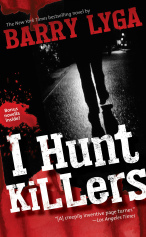 Looks like the I Hunt Killers e-book is currently available in all the usual spots for the obscenely low price of just $2.99. I don’t know how long this will last, so if you’re interested, best hop on it right away!
Looks like the I Hunt Killers e-book is currently available in all the usual spots for the obscenely low price of just $2.99. I don’t know how long this will last, so if you’re interested, best hop on it right away!
Here are some links:
Barnes & Noble (Nook)
Kobo
iBooks
July 9, 2014
Visiting the FBI
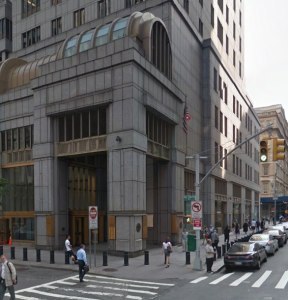 On July 7, I had the opportunity to visit the FBI field office in New York, the largest field office in the FBI. Members of the ITW (International Thriller Writers) were invited to come to the office to meet with FBI personnel for research purposes. Even though nothing in my immediate future involves writing about the FBI, I figured that this was a great opportunity, one I didn’t want to pass up. And I thought I’d write a little bit about it in case y’all are curious.
On July 7, I had the opportunity to visit the FBI field office in New York, the largest field office in the FBI. Members of the ITW (International Thriller Writers) were invited to come to the office to meet with FBI personnel for research purposes. Even though nothing in my immediate future involves writing about the FBI, I figured that this was a great opportunity, one I didn’t want to pass up. And I thought I’d write a little bit about it in case y’all are curious.
That’s the field office over there on the left, located at 290 Broadway in lower Manhattan. I didn’t think to take a picture at the time, so this one was yanked from Google Street View on August of 2013.
Once I arrived (at the unauthorly hour of 8:30am; what am I, a farmer?), I had to go through the usual security rigamarole (metal detector, etc.) and surrender my iPhone for security reasons. No iPad allowed, either. Yes, for note-taking purposes, I had to kick it old school with a reliable (and quite nice) Moleskine notebook I keep for those rare occasions when tech is verboten.
I was a bit amused that the procedure for giving up my phone went like this: I put my phone in a little Ziploc bag, wrote my name on it, and handed it over to the security dude. Hours later, the phone was out on a table with everyone else’s. I mean, I could have taken any phone. Maybe a couple. Weird.
Anyway, there were roughly 100 of us authors. We made our way upstairs to a large presentation room, where NY Field Office ADIC (Assistant Director in Charge) George Venizelos spoke to us about the Bureau and the field office in general terms. He opened up the floor for questions and was flooded with some very specific ones that he handled with good grace until a rep from the Office of Public Affairs stepped in and pointed out that this was the man in charge of the whole office and he had things to do and maybe we could hold our nitty-gritty questions for the folks “on the ground,” so to speak.
Thus began the day in earnest. The FBI’s NY office is divided into six divisions: Administrative, Criminal, Special Operations/Cyber, Intelligence, Counterterrorism, and Counterintelligence. We heard from the SACs (Special Agents in Charge) for each division, each of whom gave us a little background about themselves and then spoke about the mission of the division before taking questions.
I’m not going to regurgitate everything here because, well, there’s only so much time. We were there for several hours, after all! But here’s some basics about the divisions:
Administrative: SAC Ronald Twerskey joked that his division was hardly the most exciting. Administrative, though, is enormously important. There are something like 2500 people working out of the New York office, and Admin is responsible for everything from their desks and computers to their cars and guns. There’s an old saying that an army travels on its stomach. Well, an organization as complicated as the FBI can only function if the lights are on and its equipment works, so coordinating those logistics is enormously important. Someone asked Twerskey if the field office’s complement of agents was a large enough staff. He joked that his colleagues probably wanted more agents, but since he has to find cars, guns, desks, and computers for all of them, he’ll stick with the current roster.
Criminal: This is probably what you think of when you think of the FBI: Catching criminals. SAC Richard Frankel described the FBI’s training program at Quantico as “college, camp…and you have guns. It doesn’t get better than that!” The Criminal Division is the largest FBI division in New York, tasked with white collar crime, public corruption, violent crime, and organized crime.
Special Operations/Cyber: Next up was SAC Leo Taddeo, who talked about hacking and cybercrime. He told us that some of the vilest criminals and some of the most decorated law enforcement officers in history have both walked the halls of the New York field office, describing it as “Valhalla for law enforcement.” He said that the FBI is extremely good at identifying malicious hackers. The problem comes when the hacker is located in a country that won’t cooperate with the U.S. Knowing who the person is and being able to arrest him or her are two different things. He also pointed out that only 56% of corporations report when they’ve been hacked. (Unless it’s the sort of hack that the law requires they report.)
Intelligence: SSIA (Senior Supervisory Intelligence Analyst) Megan Hart started out by telling us that New York is such a target-rich environment for cases that one of the main functions of her unit is triaging them to figure out which ones make the most sense to go after. The function of the Intelligence division is to take a high-level view. Individual case agents are, appropriately, focused on their own cases, so the intelligence analysts look at the big picture and help to direct resources. This requires a lot of juggling, as you can imagine: The threat levels from criminal activity, terrorism, and public corruption are all different, so you can’t measure them on the same scale. But Intelligence has to identify the greatest threats, wherever they come from.
Counterterrorism (CT): SAC William Sweeney ran us through the JTTF, the Joint Terrorism Task Force, an FBI-led group that consists of almost 500 people in the New York area, including 130 NYPD officers and representatives from 52 agencies. There are 103 JTTFs around the country, but New York’s is the largest. You might imagine the JTTF was created recently, in the aftermath of 9/11, but it actually dates back to 1980, when it began with 10 FBI agents and 10 NYPD officers. For the JTTF, the FBI picks up the tab for cars and overtime for the other agencies, receiving in exchange more bodies for its investigations. We received a general overview of threats both foreign and domestic, leading me to ask during Q&A, “What keeps you up at night?” Sweeney immediately replied, “Everything,” before joking, “Well, my Blackberry.”
Counterintelligence (CI): CSSA Matt Laird began by apologizing for not having a Powerpoint presentation like many of his colleagues. “But everything I do is classified, so it would only be two slides: My name and ‘Questions?’ Most of which I can’t answer.” He paused. “I’ve probably said too much already.” Counterintelligence is, of course, the application of spy craft against spies. With the UN in New York, most countries in the world have some kind of espionage presence there via their UN missions, so Laird’s team is pretty busy. Despite his joke that he couldn’t tell us anything, Laird provided a lot of useful information, discussing the infamous Anna Chapman, for example. But, yeah, “everything is classified” and it’s no coincidence that the CI portion of my notes is the most sparse.
Lunch was listed on the schedule as a “working lunch.” Now, I usually hate working lunches, but this one was really more “lunch theater.” Retired FBI agent Dan Desimone walked us through a case of his in the late nineties, when he went undercover in Las Vegas to catch some mobsters. It was a terrific story, and it involved a mobster with the best nickname ever: Vinnie the Aspirin. If you want to know why he’s called “the Aspirin,” click on that link.
The day ended with a trip to the FBI’s private museum, which contained some truly ancient tech from the bad old days, along with memorabilia all the way up through 9/11. After that, we were free to go, and I took my phone (and only my phone) and headed home.
You might be wondering why the FBI would let a bunch of very high-level, senior staff waste a day hanging out with a group of authors. I have to admit, that thought flickered in my head for a moment, too, but ADIC Venizelos explained it right off the bat: He said that people believe what they read…whether it’s true or not. And the FBI’s job is a lot easier if people actually understand it. So it behooves the FBI to make sure writers actually get their facts straight. Weirdly enough, we live in a world where people think paying attention to a fictional account of law enforcement makes them an expert in real life law enforcement. So, yeah, I guess Venizelos is right: In such a world, you want even the people who make things up to get them right.
Thanks to ITW and the FBI for a fun, informative day! If you ever get the chance to visit the New York field office (or, I imagine, any field office), take it. You’ll learn a lot, or at least hear some great stories.
The BLog
- Barry Lyga's profile
- 2185 followers


